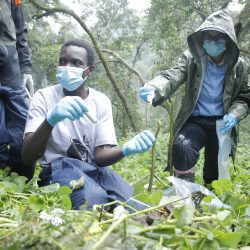Mountain Gorilla Tourism in the Wake of COVID-19; How Close Should We Get?
Blog | 3/07/20
There’s no doubt that mountain gorillas generate a good percentage of tourism revenue for the countries in which they live – DRC, Rwanda and Uganda. And that the need to suspend tourism, including visitation to mountain gorillas, has greatly affected the economies of the respective countries, the livelihoods of the park edge communities and other tourism value chain players who depended on mountain gorilla tourism for survival. And yet, we appreciate the fact that it was done in the best interest of public health and the health of the mountain gorillas and other great apes which share about 98% DNA with humans.
This closely matched DNA with humans makes them highly susceptible to human-borne illnesses, to which they have limited or no immunity at all. Mountain gorillas are a very vulnerable species and are susceptible to a wide range of diseases, including measles, scabies, tuberculosis, Ebola virus disease, flu, and other various respiratory diseases. First time exposure to an illness or virus that is relatively innocuous to humans can devastate an entire ape population. Some apes especially gorillas and chimpanzees have in the past succumbed to respiratory diseases which quickly spread from group to group/individual to individual as they interact. If a novel virus like SARS CoV-2 enters the mountain gorilla populations, the impact could be severe and increase the likelihood of extinction.

Photo by Neil Osborne
Although mountain gorilla tourism industry is profitable, it is not without risk, as thousands of people from all over the world come to visit the apes in their natural habitat. It has been determined that diseases are transmitted by the people that get in close proximity with the great apes –trackers, researchers, rangers and guides, and the tourists themselves.
As countries plan and begin to open national parks for mountain gorilla tourism several issues need to be thought through and addressed, for example, how prepared are we for the re-opening? How effective shall any set measures be if we have for the last decades failed to adhere even to the very basic of the guidelines – i.e. avoiding close contact and the use of masks when visiting mountain gorillas?
Global and regional health authorities have warned that the SARS CoV-2 virus is here to stay much longer than we originally thought. This, coupled with the recent trends of the disease manifestation and lock down of the economies and individual livelihoods indicates that life may never be the same again. This implies that we need to rethink our conservation approaches, re-strategize our actions to target crucial conservation challenges that threaten the lives of people and endangered wildlife species including; poor public health systems and measures around mountain gorilla habitats, abuse of and lax adherence to gorilla visitation rules, inappropriate marketing of tourism services by tour operators and limited knowledge on the gorilla visitation rules by tourists themselves.

Photo by Neil Osborne
With the continued lack of rule adherence, how sure can we be that tourists, researchers and rangers alike will observe the safe distance? Aware of the rugged and steep terrain of some gorilla habitats like Bwindi Impenetrable National Park that limit proper viewing or proper observance of the recommended distance and now with the SARS CoV-2 virus how close should one get to the mountain gorillas? How shall we ensure that both tourist satisfaction and the safeguarding of the mountain gorillas are all achieved?
Putting gorilla health and safety before economic gains is very key under the current circumstances for if gorilla tourism is not cautiously approached and properly managed significant risks can arise to the gorilla populations.
We need to understand that ensuring human and mountain gorilla health and safety is a precondition to the economic and social gains from mountain gorilla tourism.
To open or not to open; what’s there to lose? There’s definitely a lot to gain. If conducted appropriately the opening of mountain gorilla tourism will once again bring in the much-needed tourism revenue that funds conservation actions, supports development and livelihood improvement of park edge communities and boosts the economic growth and economic recovery of the range states. However, if rushed or conducted otherwise the opening could facilitate introduction of a novel disease and a decline in the recently celebrated increase in the gorilla population, or in a worst-case scenario, their extinction.

Photo by Ryoma Otsuka
Going forward range state governments can recognize and enforce strict adherence to best practices for prevention, as outlined in the IUCN Best Practice Guidelines for Health Monitoring and Disease Control in Great Ape Populations, as well as the Great Ape Tourism.
Governments in the gorilla range states need to develop clear cut guidelines to guide the opening of tourism and subsequent tourism activities and contingency plans (national and regional) and finance the prevention measures including provision of protective equipment, enhanced information and hygiene and sanitation facilities for tourists, park staff and community members, and private driver guides. Support and resources from the private sector, as well as conservation institutions and donors, will be necessary. Collaboration of the trans-boundary range states in the protection of mountain gorillas against SARS CoV-2 and the prevention of an outbreak is very pertinent too.
Ultimately, it is likely that mountain gorillas, and the tourism they support will be part of the economic recovery of the range states after the devastating blow the COVID-19 pandemic has caused. The re-opening however shouldn’t be rushed. All the tourism value chain players need to be brought together and involved to play their rightful roles to secure the future for mountain gorillas, and in turn secure livelihoods and economic growth over the long term.



